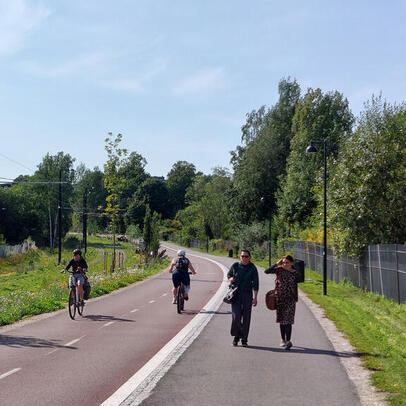
What impacts do my mobility choices have?
You can influence traffic emissions with your own choices, for example, by favouring sustainable modes of transport, using your private car less, or choosing a low-emission vehicle.
- The City of Helsinki aims to be carbon neutral by 2030. Reductions in traffic emissions are critical for Helsinki to achieve its climate targets.
- According to forecasts, traffic is set to become the most significant source of emissions in Helsinki in 2025.
You can have an effect on air quality and the sound environment by favouring sustainable forms of mobility and choosing to use friction tyres on your car, as they are quieter than studded tyres and have been proven to reduce the formation of street dust.
- Air quality in Helsinki has improved over the past decades, but air pollution does reduce air quality from time to time. Traffic exhaust gases and street dust are the most significant factors for the deterioration in air quality, as they are discharged close to the height we breath in.
- Environmental noise significantly reduces the quality and comfort of the living environment in Helsinki. Intense continuous noise can also be a health hazard. Road traffic is the greatest source of noise in Helsinki. 39% of Helsinki residents live in areas where the noise level from road traffic exceeds the daytime limit value of 55 dB.
You can help reduce congestion by favouring sustainable modes of transport. The more people choose modes of transport that save space, the smoother traffic in the city will be. When traffic requires less space, we can make use of the urban space to improve comfort with plantings, for instance.
You can reduce the amount of microplastics that end up in the environment by walking, cycling or using public transport. When you drive a car, you can influence emissions driving in a way that reduces tyre wear and by favouring friction tires instead of studded tires in winter.
- Road transport is the largest single source of microplastics. In particular, car tyres release a significant amount of microplastics. Ploughed and piled up urban snow is also a significant source of microplastics.
- Microplastics that are released in traffic end up in the Baltic Sea along with rainwater. The impact of microplastics on the environment is not yet fully known. However, studies have found that it is harmful to marine microorganisms and that it accumulates in the food chain. Once microplastics find their way to the seas, it is impossible to remove.

Electric vehicles for everyday use
Electric vehicles are rapidly becoming more common in Helsinki. The city's goal is to reduce the number of combustion engines in urban areas. The city supports the electrification of transport by developing a comprehensive EV charging network and encouraging residents to switch to electric vehicles, for example, with a 50% discount on parking.
Many housing companies and workplaces have begun to install EV chargers, and most of the charging is done overnight at home or during the workday in the workplace’s parking lot.
There are about 250 public EV chargers in the city's street parking areas. The charger network in street parking areas is concentrated in the inner city. These chargers make use of renewable wind power. The charger network in Helsinki’s street parking will be expanded gradually.
There are plenty of charging points in shopping centres, sports facilities and parking garages. There are numerous charging options for travellers near the city's attractions and tourism spots.
It is also possible to charge EVs in HSL’s park-and-ride service(Link leads to external service) .
Check out the map of charging points (latauskartta.fi)(Link leads to external service)
High-power charging
You can also find high-performance charging points, i.e. fast charging points, in Helsinki. They can be used to fully charge your car's empty battery in less than 30 minutes.
- Choice of electric vehicle (Motiva, in Finnish)(Link leads to external service)
- EV charging (Motiva, in Finnish)(Link leads to external service)
- Vehicle Calculator – compare vehicle emissions and costs (Climate Panel, in Finnish)(Link leads to external service)
- Environmental impact of electric vehicles (Motiva, in Finnish)(Link leads to external service)

Shared-use vehicles
Vehicle sharing is a convenient option for sustainable mobility in Helsinki. Public transport is easily accessible with city bikes, for example. By combining the different means of transport, you can choose a suitable and sustainable way to move around Helsinki.
Using Helsinki Region Transport’s (HSL) yellow city bikes is effortless in the daily life of a mobile city resident. There are nearly 4,600 bikes in use in the Helsinki and Espoo area, finding the nearest station is easy with the HSL mobile app.
It is also possible to rent bicycles, for example, through a peer-to-peer rental service.
City Bikes (HSL)(Link leads to external service) (Season 1 April–31 October)
Hygglo peer-to-peer rentals (in Finnish)(Link leads to external service)
Several companies provide electric scooter rental in Helsinki.
Bird(Link leads to external service)
Bolt(Link leads to external service)
Lime Scooters(Link leads to external service)
Ryde(Link leads to external service)
Tier(Link leads to external service)
Shared cars are well suited to the occasional need for a car. The car can be used even for as little as a few hours at a time, and there are pickup points around the metropolitan area.
- Aimo Share car sharing(Link leads to external service)
- Omago(Link leads to external service)
- 24Rent(Link leads to external service)
Peer-to-peer rental:
The circular economy service map includes shared-use vehicles and mobility services in the Helsinki Metropolitan Area. The service map includes, among other things, cargo bicycles and trailers that are available to loan. The map also includes the locations of these vehicles.
Circular economy service map(Link leads to external service)
Is your company not on the list? Contact: kymp.ymparistovaikutukset@hel.fi(Link opens default mail program)


